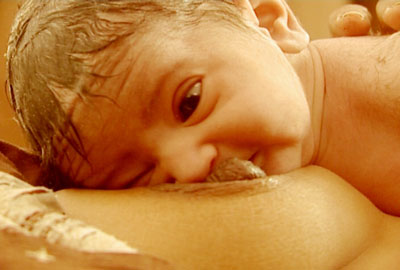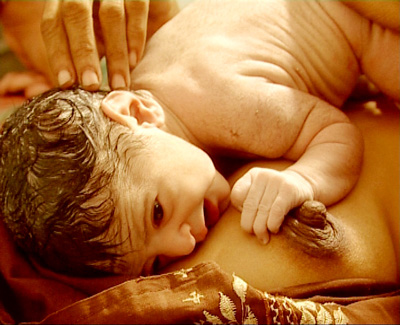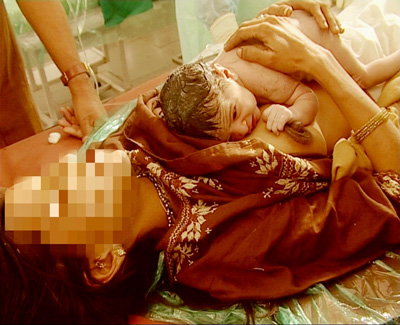
1. Introduction
The Breast Crawl was described 20 years ago. The discovery, in spite of its tremendous potential, has failed to reach the beneficiaries (i.e. mothers
and infants) at large. The scientific community, the medical fraternity, health managers, breastfeeding advocates and international health
organizations have missed out on a powerful 'change' agent for early initiation and hence short and long term breastfeeding success. We tried to
analyze the reasons for this failure and observed that:
- Article Titles do not mention the Breast Crawl: Most articles related to the Breast Crawl, including the first one which
described the phenomenon (Widström et al, 1987), have titles which convey the aims of the study with great clarity without mentioning the
word 'Breast Crawl', even though the babies were kept in the 'Breast Crawl' position.
- Transition from Verb to Noun: Klaus (1998) used the term 'Breast Crawl' as a 'noun' for the first time. All
previous studies have used it as a 'verb'. We feel that this is a landmark transition which resulted in widespread use of the term 'Breast
Crawl'. Had this significance been realized earlier, perhaps the titles of many Breast Crawl studies could have used the term.
- Breast Crawl and Search Engines: Interestingly, simply because most article titles do not mention the
term 'Breast Crawl', the internet search yields very few articles when the search engines use this term.
- Recommendation failures: The body of scientific evidence presented in the previous section is strong enough
to recommend 'Breast Crawl' as 'the method' for initiating breastfeeding. However, there has been no such widespread
recommendation. In fact, no particular method for initiation of breastfeeding has been recommended by the BFHI documents.
The purpose of this dossier, and our mission, is to strongly recommend an
evidence based workable method in form of the Breast Crawl for initiation of breastfeeding. This is especially relevant when the focus of World
Breastfeeding Week for 2007 is on 'Initiation of Breastfeeding'.

2. Recommendations and Breast Crawl
WHO and UNICEF BFHI documents' subtle descriptions of the initiation of breastfeeding are similar to the process of the 'Breast Crawl'. If
interpreted properly and practised in its true spirit, initiation of breastfeeding would naturally follow the 'Breast Crawl' pattern.
By the time the foundation stone of the Baby Friendly Hospital Initiative was laid, the Breast Crawl had already been discovered. This was reflected
in the 'Joint WHO / Unicef Statement' (1989) as 'The newborn infant should therefore be cleaned and dried and placed over the mother's abdomen
for her to take and put to her breast.'
WHO and UNICEF BFHI documents have evolved since 'Ten Steps to Successful Breastfeeding' were described in 1989. Though the 4th step
remains unchanged, the interpretation has changed with time.
The initiation of breastfeeding comprises of two components i.e. skin-to-skin contact and suckling. These were discussed and differentiated
subsequently (WHO, 1998).
'Early skin-to-skin contact and the opportunity to suckle within the first hour or so after birth are both important. However, contact and
suckling are so closely interrelated that most studies reviewed have used the terms interchangeably, and few researchers distinguish clearly between
them.
Optimally, the infant should be left with the mother continuously from birth, and allowed to attach spontaneously to the breast whenever she shows
signs of readiness to do so. An arbitrary but practical minimum recommendation is for skin-to-skin contact to start within at most
half-an-hour of birth and to continue for at least 30 minutes.'
Revised BFHI guidelines (UNICEF/WHO, 2006) interpret 'Step 4' as 'Place babies in skin-to-skin contact with their mothers immediately following
birth for at least an hour and encourage mothers to recognize when their babies are ready to breastfeed, offering help if needed.'
The same document further defines the 'Revised Global Criteria' for Step Four' as 'At least 80% mothers confirm that their babies were placed in
skin-to-skin contact with them immediately or within five minutes after birth and that this contact continued for at least an hour, unless
there were medically justifiable reasons for delayed contact.'
The revised criteria have precisely defined the maximum upper limit of the interval between delivery and initiation of breastfeeding as five minutes
which is consistent with the recommendation by Klaus and Kennel (2001):'Once
it is clear that the baby has good colour and is active and appears normal (usually within 5 minutes), she can go to her mother.'
The interpretation, description and global criteria for Step four in Revised BFHI Guidelines almost matches the process of 'Breast Crawl' with some
subtle differences which are tabulated below:
| |
Breast Crawl |
Revised BFHI Guidelines |
| Process labelled |
Yes |
No |
| Abilities of the newborn addressed |
Yes |
No |
| Start position |
Nose in the midline of the mother's chest, eyes at the level of the nipples |
Only one of the positions is similar to the Breast Crawl |
| Recommended duration of skin-to-skin contact |
Till completion of the first breastfeed |
For at least one hour |
We have following suggestions to strengthen the
Revised BFHI guidelines (UNICEF/WHO, 2006)
- Define and describe in detail a specific method to initiate breastfeeding.
- The 'Breast Crawl' would help to bridge this gap.
- Labelling or naming the process will tremendously help the implementation.
The slogan for the World Breastfeeding Week for 2007 has
focussed on initiation in one hour because it is linked to a study in Ghana
(Edmond, 2006) where neonatal mortality was studied for initiation within
one hour. It should not therefore be misunderstood that WABA recommends
delaying initiation of breastfeeding to 'within an hour'. WABA supports 'Ten
Steps to Successful Breastfeeding' and Revised BFHI Guidelines.

3. Our Vision
The Breast Crawl, to our mind, is the most natural, spontaneous and logical method of initiating breastfeeding. It is also the simplest method
that provides prolonged skin to skin contact and culminates in the first breastfeed. It is easy, does not require elaborate preparations, can be done
in any setting and is readily reproducible. We recommend that every baby (and mother) should be given an opportunity to experience this miracle.
3.1 Ideal Recommendations
3.2 Implementing Breast Crawl as the method of
initiation of breastfeeding.
3.3 Breast Crawl E-Dialogue
3.4 Breast Crawl Summit
3.5 Avenues for Research
3.1 Ideal Recommendations
Every minute after birth is crucial. The mother-baby interactions are
extremely complex and precise like a computerized programme. All healthcare
providers need to understand this process, which also is genetic,
instinctive, unlearnt behaviour.
Current recommendations need subtle updating in the light of the evidence presented
A description of the precise method of supporting initiation of breastfeeding i.e. the Breast Crawl.
- A discussion of the sensory and motor abilities of the newborn.
- Educating all the health workers and mothers (as well as fathers and other close relatives) about these abilities, so as
to empower them to explore these abilities, for the benefit of the mother and the baby.
- The need to continue skin-to-skin contact, until completion of the first breastfeed.
At a later stage WHO / UNICEF can consider adding just two words to the fourth step as follows:
4. Help mothers initiate breastfeeding within a half-hour of birth by the 'Breast Crawl'.
At a still later stage the step can be further updated to the following:
4. Help mothers initiate breastfeeding within five minutes of birth by the 'Breast Crawl'.
We also visualize the need to talk about the 'Extended Period of Initiation'.
Classically, 'Initiation of Breastfeeding' means the first contact and the first breastfeed. However, there is a need to talk about an 'Extended Period
of Initiation'. This period can be considered as the entire period from birth till the time lactation is established. Realizing the importance of
this period ILCA has published a document 'Clinical Guidelines for the Establishment of Exclusive Breastfeeding' in June 2005. The document focuses
on issues such as frequency of feeding, realizing early feeding cues, waking up a sleepy infant, the need for mothers to learn positioning and
attachment, monitoring for adequacy etc., in addition to other important points. Discussing this period would link Step 4 to other steps especially
Step 5, 7 and 8. The lessons from the Breast Crawl, like skin to skin contact and the newborn's spectrum of abilities would come handy in this
period. Some of the mothers whom we have seen initiating breastfeeding by the Breast Crawl, continued to use the 'crawling in position'
advantageously, so as to establish successful breastfeeding. Though 'Kangaroo Mother Care' was invented to care for low birth weight babies, we
visualize a unification of this concept with the Breast Crawl, in this extended initiation period, for normal full term newborns.
3.2 Implementing the Breast Crawl as the method of initiation
BPNI Maharashtra is collaborating with the Government of Maharashtra, with
support from UNICEF, to train health care providers in 'Basics of IYCF'. The
delegates undergoing this training are given a demonstration to initiate
breastfeeding by Breast Crawl. Those delegates working in the maternity
service have started implementing Breast Crawl whenever possible. However,
for wider implementation, more intense efforts will be necessary. These will
be vigorously followed-up over the next one year.
3.3 Breast Crawl E-Dialogue:
The documentary on Breast Crawl that accompanies this dossier will be sent
to health professionals, researchers and breastfeeding advocates round the
world. A discussion on this will be initiated by E-dialogue as well as other
means. This should culminate in a Breast Crawl Summit. Both the documentary
and the dossier can be put up on multiple websites for open review. WABA can
play a crucial role in the dissemination of this material, along with
distribution of resource material for this year's World Breastfeeding Week.
3.4 Breast Crawl Summit
UNICEF, WHO and WABA can jointly hold this summit before or during the World Breastfeeding Week. The goals for the summit will be:
- To consider Breast Crawl as 'the method' for initiating Breastfeeding.
- Recommendations on Step 4 to Revised 2006 BFHI Guidelines.
- Further recommendation for worldwide implementation of the Breast Crawl
- Discussion on further research avenues on the Breast Crawl.
3.5 Avenues for Research
- Studies on implementing the Breast Crawl as the recommended method for
initiation and solutions to overcome problems (practicability / feasibility).
- Impact on initiation rates after using the Breast Crawl as 'the method' for initiating breastfeeding.
- Studies of the Breast Crawl with larger sample sizes and without hindering factors.
- Detailed studies on the role of various hindering factors with large
sample size and with special reference to newer regimes for labour analgesia.
- Breast Crawl in low birth weight babies. This will be important for
developing countries which have a high incidence of low birth weight babies.
- Role of infant vision in the Breast Crawl with special reference to evolutionary differences in areola pigmentation.
- Effect of initiating breastfeeding with the Breast Crawl on the establishment of lactation, exclusive breastfeeding for six months and
long term breastfeeding success.
- Role of 'Crawling in' as an advance over 'bedding in' and 'rooming in'.
Routine use of amniotic fluid application on nipples to augment the Breast Crawl.
- Isolation of chemical from the nipple and amniotic fluid. This may be
useful to encourage babies that suddenly refuse to breastfeed.

